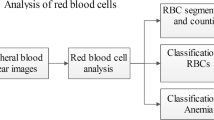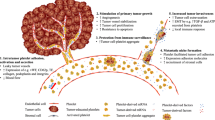Abstract
The reduction of mean corpuscular hemoglobin (MCH) and mean corpuscular hemoglobin concentration (MCHC) whereas increasing of reticulocytes number and indirect bilirubin after 20 weeks of experiment of dimethylhydrazine (DMH)-induced colon carcinogenesis indicate the hemolysis of red blood cells due to the DMH influence during tumor development. The slight increasing of number of monocytes and platelets, as well as considerable increasing of a number of eosinophilic granulocytes, has been observed. Reduction of number of hemoglobin and erythrocytes, slight increase of number of monocytes, and significant increase in number of platelets in blood of rats follows 26 weeks of the experiment (after 6 weeks of DMH discontinuation). Anemia with thrombocytosis accompany cancer in humans and the model of DMH-induced colon cancer is appropriate not only for studies of carcinogenesis and searching of new antineoplastic drugs but also for the development of correctional approaches of cancer-associated changes in the hematopoietic system.
Similar content being viewed by others
References
Jemal, A., Bray, F., Center, M.M., et al., Global cancer statistics, Ca-Cancer J. Clin, 2011, vol. 61, no. 2, pp. 69–90.
Perse, M. and Cerar, A., Morphological and molecular alterations in 1,2-dimethylhydrazine and azoxymethane induced colon carcinogenesis in rats, J. Biomed. Biotechnol., 2011. doi: 10.1155/2011/473964
Damry, S., Ryan, R., Wilson, S., et al., Iron deficiency anemia and delayed diagnosis of colorectal cancer: a retrospective cohort study, Colorectal Dis., 2011, vol. 13, no. 4, pp. e53–e60.
Meditsinskie laboratornye tekhnologii: Spravochnik (Medical Laboratory Technology: A Handbook), Karpishchenko, A.I., Ed., St. Petersburg: Intermedika, 2002.
Harzallah, H.J., Grayaa, R., Kharoubi, W., et al., Thymoquinone, the Nigella sativa bioactive compound, prevents circulatory oxidative stress caused by 1,2-dimethylhydrazine in erythrocyte during colon postinitiation carcinogenesis, Oxid. Med. Cell. Long, 2012. doi: 10.1155/2012/854065
Lynchak, O.V., The influence of the maleimide derivative on the condidtion of the normal rat liver and bowel and with chemical-induced carcinogenesis of the colon, Extended Abtract of Cand. Sci. (Biol.) Dissertation, Kyiv, 2010.
Kaushansky, K., Lichtman, M., Beutler, E., et al., Williams Hematology, New York: McGraw-Hill, 2010.
Raval, G., Straughen, J.E., McMillin, G.A., and Bornhorst, J.A., Unexplained hemolytic anemia with multiorgan failure, Clin. Chem., 2011, vol. 57, no. 11, pp. 1485–1489.
Hamiza, O.O., Rehman, M.U., Tahir, M., et al., Amelioration of 1,2-dimethylhydrazine (DMH) induced colon oxidative stress, inflammation and tumor promotion response by tannic acid in Wistar rats, Asian Pac. J. Cancer Prev., 2012, vol. 13, no. 9, pp. 4393–4402.
Filinska, O., Yablonska, S., Mandryk, S., et al., Effect of maleimide derivative on oxidative stress and glutathione antioxidant system in 1,2-dimethylhydrazine induced colon carcinogenesis in rat, Ann. Univ. Mar. Curie-Sklodowska, 2010, vol. 23, no. 3, pp. 191–195.
Perse, M., Oxidative stress in the pathogenesis of colorectal cancer: cause or consequence? BioMed Res. Int., 2013. doi: org/10.1155/2013/725710
Filinska, O.M., Yablonska, S.V., Mandrik, S.Ya., et al., State of the liver antioxidant system and content of matrix metalloproteinase-2 of the large intestine under the effect of maleimide derivative in experimental colorectal carcinogenesis in rats, Ukr. Biokhim. Zh., 2010, vol. 82, no. 4, pp. 69–77.
Jacobs, M.M., Forst, C.F., and Beams, F.A., Biochemical and clinical effects of selenium on dimethylhydrazine-induced colon cancer in rats, Cancer Res., 1981, vol. 41, pp. 4458–4465.
Takeuchi, K., Bjarnason, I., Laftah, A.H., et al., Expression of iron absorption genes in mouse large intestine, Scand. J. Gastroenterol., 2005, vol. 40, no. 2, pp. 169–177.
Calabrich, A. and Katz, A., Management of anemia in cancer patients, Future Oncol., 2011, vol. 7, no. 4, pp. 507–517.
Abdullah, A.R., Abdulfattah, S.Y., Ali, H.M., et al., Increasing serum level of tumor necrosis factor alpha in some gastrointestinal cancers in Iraqi patients, Egypt J. Exp. Biol., 2012, vol. 8, no. 1, pp. 49–54.
Dicato, M., Plawny 1, L., and Diederich, M., Anemia in cancer, Ann. Oncol., 2010, no. 7, pp. 167–172.
Takahashi, S., Kosaka, T., Hattori, M., et al., Cancerrelated anemia: correlation analysis among serum levels of hemoglobin, il-6, hepcidin, albumin, and erythropoietin, J. Clin. Oncol., 2009, vol. 27, no. 20, p. e20655.
Prizment, A.E., Anderson, K.E., and Visvanathan, K., Inverse association of eosinophil count with colorectal cancer incidence: atherosclerosis risk in communities study, Cancer Epidemiol. Biomark. Prev., 2011, vol. 20, no. 9, pp. 1861–1864.
Bogels, M., Braster, R., Nijland, P.G., et al., Carcinoma origin dictates differential skewing of monocyte function, Oncoimunology, 2012, vol. 1, no. 6, pp. 798–809.
Author information
Authors and Affiliations
Corresponding author
Additional information
Original Ukrainian Text © I.V. Byelinska, O.V. Lynchak, T.V. Rybalchenko, S.V. Yablonska, O.M. Bahurynska, V.K. Rybalchenko, 2015, published in Tsitologiya i Genetika, 2015, Vol. 49, No. 3, pp. 23–30.
About this article
Cite this article
Byelinska, I.V., Lynchak, O.V., Rybalchenko, T.V. et al. Morphofunctional parameters of blood cells of a rat with 1,2-dimethylhydrazine-induced colon carcinogenesis. Cytol. Genet. 49, 158–164 (2015). https://doi.org/10.3103/S0095452715030044
Received:
Published:
Issue Date:
DOI: https://doi.org/10.3103/S0095452715030044




